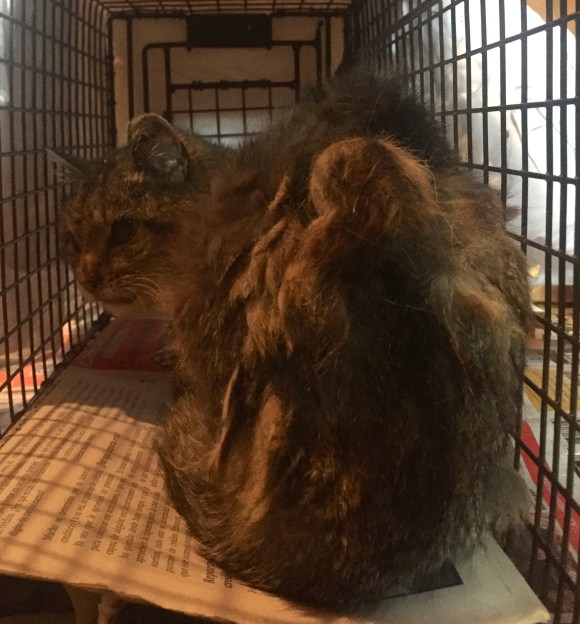A young man named Atticus was worried about a TNR’d colony cat on his block. The cat was acting sick and lethargic, so Atticus posted this heartbreaking message on Everyblock, asking for help:
“so there’s a feral cat, a sweet old man, who lives on my block. i think a neighbor across the street usually feeds the colony, because i see them hanging on his porch a lot.
the old man cat seems like he’s really sick. his nose is all crusted and he’s on my back porch right now, seeming like he has a bit of trouble moving. he’s just hunched there, breathing heavily.
i know not to touch him, because he’s definitely an ear-tipped feral. i tried to make him comfy, brought him a little bit of food. he sat up when i got near him, but did not run, which is one of the ways i know he is not doing well, because he used to run when i got within 30 ft orso of him.
i guess my question is, am i caring too much for what is basically a wild animal? he surely won’t even live the month without medical attention, but he is ‘no ones’ cat, just there to keep the rat population down.. i’m not posting to say, “dang i don’t want this guy to die on *my* porch!” as much as i am saying, “is there a way we can do something for him?”
i don’t have the money to pay for medical attention for him, and i’m not sure if it’s even a cause worth fighting for because he might just be old as hell and withering with age.
thanks, neighbors. i’m sorry to post something so bummerific, i just love this old cat.”
Joann and Kim brought traps to Atticus. Atticus and his girlfriend, Katie, watched the traps day and night. This sick cat would come and go, and sat by the trap for a few days.

In the meantime, they trapped another black cat. They named her Ditto, and she received her TNR treatment at the Anti-Cruelty Society’s clinic.
Finally, after a week of setting traps, the sick cat went in.


We went to our friend, Dr. James Harris, at Elmhurst Animal Care Center. We found out there that this sweet “old man cat” was actually a female. She was a senior cat, sick with upper respiratory infection – URI, underweight, had only a few teeth left, and had some pretty extensive mats on her back. They also found her microchip from her TNR, which was traced to PAWS’ clinic.
 The Elmhurst clinic sedated her, did her bloodwork and FIV/FeLV test, and gave her an antibiotic injection of Convenia for her URI. They carefully clipped off her mats, but left the fur intact underneath. Afterwards I set her up in my feral cat recovery lounge. Her total vet bill was $121. If you’d like to make a donation towards her care, you can do so through the Paypal donation link at the top of this page, or directly through paypal.com with [email protected]
The Elmhurst clinic sedated her, did her bloodwork and FIV/FeLV test, and gave her an antibiotic injection of Convenia for her URI. They carefully clipped off her mats, but left the fur intact underneath. Afterwards I set her up in my feral cat recovery lounge. Her total vet bill was $121. If you’d like to make a donation towards her care, you can do so through the Paypal donation link at the top of this page, or directly through paypal.com with [email protected]

In the meantime, PAWS let us know that she was TNR’d in 2010 on the same block we trapped her. Her name was Stacy. The person who TNR’d her has since moved from the block. She was the only cat she ever TNR’d because Stacy kept having litters of kittens. But Stacy had other feeders caring for her since then, including Atticus, and his neighbor across the street.
The next day Dr. Harris informed us that she tested negative for FIV/FeLV, but her bloodwork results were dismal. She would need ongoing daily medication and care for lymphoma, most likely. This was just not possible in her situation and Stacy was already very sick. She was acting very lethargic, barely moving in the dog crate, yet very scared and stressed at being confined. At the same time, if we put her back outside, she was not in a situation where she stayed in a single place and could take daily medicine and daily care. Winter was coming and the cold would eventually kill her. After much discussion between all of us, Jenny N. at PAWS offered to take her to their clinic and euthanize her.
RIP, Sweet Stacy. You were surrounded by love at the end of your life, and brought a lot of people together who tried to help you the best way we could. We are so grateful for the compassion of Atticus and Katie for caring for her, for reaching out to the local Everyblock community, and to the vet care from Elmhurst and PAWS. Every animal deserves a dignified and humane death when they are suffering, and this is why we provide that care as best as we can to the colony cats.




















